Mazda3 for 2014: A Car for Any Year
By John Gilbert
The 2014 Mazda3 is a quick and agile compact that has a distinctive flair and the ability to change directions instantaneously — much like its namesake company.
In an automotive world dominated by companies large enough to resemble cruise ships, Mazda is more like a speedy runabout, able to change directions almost immediately. A year ago, Mazda introduced its CX-5, a newly engineered compact SUV holistically built from the ground up to Mazda’s just-revealed Skyactiv technology. The vehicle impressed all who drove it or looked at it, and it finished as runner-up to the revised Ram 1500 in the North American Truck/Utility of the Year competition.
That was just the tip of the Skyactiv iceberg, and the company has followed up with an impressive midsize sedan makeover for the Mazda6. And now it has produced the compact Mazda3.
The result is that both the Mazda3 and Mazda6 are among the candidates on the short list for the 2014 North American Car of the Year award. In a year where the candidate list is filled with flashy sports cars, luxury sedans, sporty sedans, and economy cars, and even its larger sibling, the Mazda3 concedes nothing, and its technology, appearance and performance mean it must be seriously considered by all jury members who drive it.
The full list of car candidates voted onto the short list is, in alphabetical order: the BMW 4 Series, Cadillac CTS, Chevrolet Corvette Stingray, Chevrolet Impala, Infiniti Q50, Jaguar F-Type, Kia Cadenza, Lexus IS, Mazda3, Mazda6, Mercedes-Benz CLA, and the Toyota Corolla. In addition, truck/utility candidates are: Acura MDX, BMW X5, Buick Encore, Chevrolet Silverado, GMC Sierra, Hyundai Santa Fe LWB, Jeep Cherokee, Kia Sorento, Land Rover Range Rover Sport, Nissan Rogue, Subaru Forester, and the Toyota Tundra.
Some of the car candidates are priced well over $50,000, and even over $75,000. That also has to work in favor of the Mazda3, which has a price range of $16,945 for the most basic I-SV model with a stick shift, and it ranges upward to $18,445 for the I-Sport, $19,595 for the I-Touring, and up to $22,745 for the I-Touring with technology and GT packages. The same models with the 2.0 and 6-speed automatic is about $1,000 more all the way up. The 2.5-liter engine comes only with the automatic, in either S-Touring at $24,595 or the S-GT at $25,995.It was in the current Mazda3 that Mazda gave out the first version of its Skyactiv engine, but even though it had the internal technical assets of smaller bore, longer stroke, and higher compression, the proposed engine had to be reduced in size, by trimming away much of the exotic exhaust manifold, to fit into the existing engine compartment. Still, the car attained 40 miles per gallon in real-world driving tests. Along with the vow that all its new engines would be built to Skyactiv standards, Mazda built the CX-5 with a wide front end, following design standards set by current company concept vehicles and wide enough to house the full Skyactiv treatment in its 2.0-liter 4-cylinder engine.
An all-new in-house pair of 6-speed transmissions, both manual and automatic, accompanied the new engine, and they are wisely calibrated for optimum fuel efficiency, but without tampering with Mazda;s hard-earned reputation for “zoom-zoom” driving enjoyment. Some critics charged that as high-tech as they were, Skyactiv powered Mazda3 and CX-5 models were less than hustling in acceleration. Mazda already had that covered, and came out with a larger, 2.5-liter Skyactiv 4 in the larger Mazda6. They also offered it as an optional engine in the CX-5.
The redesign of the Mazda3 follows, and also gets both engines — the full-manifold 2.0 with its 155 horsepower and 150 foot-pounds of torque for optimum fuel efficiency, and the 2.5 with 184 horsepower and 185 foot-pounds for those who want instant gratification from the input of their right feet, with only a moderate decrease in fuel economy.
There is far more to the technology involved with the new Mazda3, with features such as a definite similarity in styling to the CX-5 and Mazda6, following the company rules to adapt to the “Kodo” design language, and a carefully designed intuitiveness in the operation of the computerized information system. But it remains the technology of mold-breaking coordination of all elements — engine, transmission, aerodynamics and actual parts and panel design — that sets the Mazda3 above and beyond its compact competitors.
Virtually every other company designs and builds a new model, then suggests which engine should be placed under the hood. But it’s unprecedented to start with a clean sheet of paper while engineers, transmission builders and wind-tunnel scientists compare notes with body-shape designers and engine builders. The coordinated and holistic approach is what all goes into the Skyactiv strategy.
Dave Coleman, the chief engineer on the Skyactiv application for the U.S. market said he’s been working on the Skyactiv plan for several years. “Starting with the CX-5, we reengineered the whole vehicle by doing everything in a coordinated manner,” he said. “We had the engine finished before the new Mazda3 was ready, so we decided to put it into the existing car, and the results were impressive. The 155 horsepower and 150 foot-pounds of torque may not sound like that much of an improvement, but the power peak is 3,000 RPMs lower, and it has a flat torque curve that carries all the way up.
“We don’t really target performance numbers, because it doesn’t matter how high the numbers are, it’s what you get right now that matters. It’s all about balance, and how it feels. We’re always careful of car enthusiasts, and they’ll appreciate the higher compression, because that captures the most energy out of every drop of fuel.”
The exotic internal design of the engine has specially designed pistons with smaller bore and longer stroke, plus direct injection and Miller-cycle valve opening delay for optimum fuel-burning, gives the 2.0 a 13-to-1 compression ratio, but is designed to run on regular fuel.
The manual shifts with a smoothness that will leave drivers groping for superlatives and exceptionally costly cars for comparison. Mazda anticipates a take rate of 12-15 percent for manuals on the 2.0, and over 15 percent on the 2.5. Without question, the stick-shift version of the 2.0 is more than adequate for performance, and after only a preliminary drive in the mountains east of San Diego, that would be the way I’d order the car. The automatic is also very slick, and is certainly peppier with the 2.5. It has a sport button, which, when deployed, alters the shift mapping so it downshifts quickly when going into a corner, and holds each gear longer before upshifting when you’re coming out of the curve.
Designer Derek Jenkins used to work at Volkswagen, back when the first Mazda3 came out. “It was in 2003,” he recalled, “and the Mazda3 chjanged the mundane look of the whole segment. We benchmarked the Mazda3. I joined Mazda in 2009, and the Kodo design language was just evoling into the CX-5 and Mazda6, and this Mazda3 is the third installment.”
Jenkins pointed out the changes in architecture, with the apex of the curved roofline coming 80 millimeters farther back, which places the focal point of the silhouette more on the rear. The sedan has a striking “4-door coupe” shape to it, and a coefficient of drag of a remarkably low 0.255 — best in the segment. The 5-door hatchback has a cd of 0.275. Every detail of the design contributed to the low numbers.
“We spend a tremendous amount of time on the clay models,” Jenkins said. “We have such talented sculptors, they were able to design great tension between the lines of diffusion, and give the car a lean, athletic shape. We didn’t want it to be slab-sided. The face still has a smile, but it’s more aggressive without being over the top. The 5-point, 3D grille blades are snarky, with an aggressive look from the curved overline.”
One of the ways the design and aero scheme work together is the use of active grille shutters, which close at higher speed, when less cooling is required, to direct airflow under the body. It contributes to the Kodo design, in which the entire vehicle is supposed to mimic the tension of a jaguar or mountain lion in that moment when they are poised to strike.
That’s another of the colorful ideas from the Hiroshima, Japan, based company. Its previous concept cars followed the Nagare scheme, which evoked the appearance of wind and water as they flow over the contours of a rock.
I like the existing Mazda3, but there’s no question the 2014 model is on an entirely new plateau. I think the Mazda6 is an exceptionally designed car, and to offer evidence of how good the Mada3 looks, I was trying to pick a car with the 2.0 automatic for the next part of a scheduled road segment at the introduction.
“How about that one over there,” I asked, pointing at one that was only visible form the front pillars forward.
“You can’t take that one,” I was told. “That’s a Mazda6.”
Side by side, and maybe with a CX-5 next to them, all look remarkably similar from the pillar forward. The better to house all the Skyactiv tricks.
Comments
Tell me what you're thinking...
and oh, if you want a pic to show with your comment, go get a gravatar!


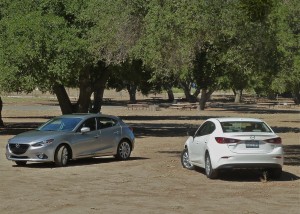
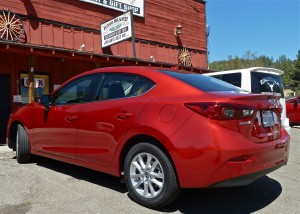
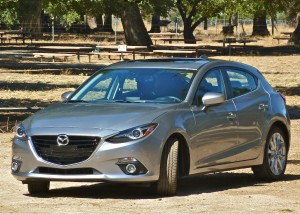
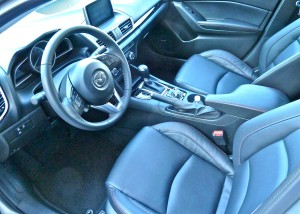
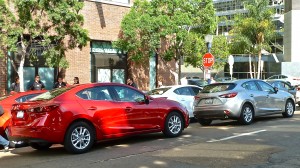
 John Gilbert is a lifetime Minnesotan and career journalist, specializing in cars and sports during and since spending 30 years at the Minneapolis Tribune, now the Star Tribune. More recently, he has continued translating the high-tech world of autos and sharing his passionate insights as a freelance writer/photographer/broadcaster. A member of the prestigious North American Car and Truck of the Year jury since 1993. John can be heard Monday-Friday from 9-11am on 610 KDAL(www.kdal610.com) on the "John Gilbert Show," and writes a column in the Duluth Reader.
John Gilbert is a lifetime Minnesotan and career journalist, specializing in cars and sports during and since spending 30 years at the Minneapolis Tribune, now the Star Tribune. More recently, he has continued translating the high-tech world of autos and sharing his passionate insights as a freelance writer/photographer/broadcaster. A member of the prestigious North American Car and Truck of the Year jury since 1993. John can be heard Monday-Friday from 9-11am on 610 KDAL(www.kdal610.com) on the "John Gilbert Show," and writes a column in the Duluth Reader.